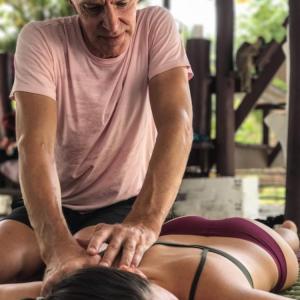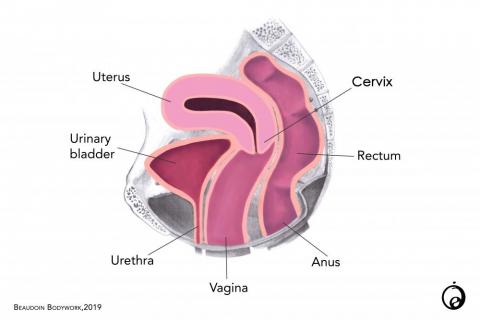I used to get a little impatient when I heard the expression "Yoni massage"; why use foreign words if not to sound mystical. Then, after practicing gynecological, Karsai nei tsang and yoni massage for about 4 years, I understood that the three approach are fundamentally different, but complementary. Here I will summarize the three approaches with their respective benefits and limitations. In practice, I suggest doing 1-3 gynecological massage sessions before doing a yoni massage. This allows you to get to know each other, and make sure no physical issues will get in the way of the goals. For more details on my approach to yoni massage or gynecological massage, please refer to my other blogs.
Let’s get it right: Vulva vs Vagina – simple anatomy of female sexual organs
First, let’s clarify the space on which we will focus, as illustrated in Figure 1. The vulva is the external part of the women’s reproductive organs, whereas the vagina is the internal part just past the vulva in which we can insert a finger, a penis or a small clean object. So what you see between a woman’s legs, with or without hair, big or small, pink, brown, red or black - is the vulva, not the vagina. There is a great variation in shapes, sizes and colors of vulvas, and they should all be celebrated as beautiful. The uterus and the ovaries are internal parts that are higher in the belly, not generally accessed internally.
The vulva and the vagina are anatomically very complex, composed of many muscles, ligaments, bones, veins, arteries, nerves, and of course the clitoris and the cervix. The anatomy is very important to gynecological massage, as it is a medical massage that strives to heal genital issues. However, in yoni massage, we do not focus much on the structures as much as the energy gates that we call tantric spots. Finally, karsai nei tsang is a limited form of massage that focuses on deposits of sedimentation (essentially accumulation of keratin, the same protein as in scars) throughout the genitals and the rectum.
Yoni massage
The yoni massage is an ancient tantric practice to improve general genital health, release past trauma, and open women's sexuality to new pleasures. Modern training normally involve a good comprehension of consent and boundaries, basic bodywork, trauma release, manipulation of sexual energy, basic genital anatomy, and a variety of yoni massage techniques.
Gynecological massage
Gynecological massage has been practiced for centuries in Europe and North America, and resembles many traditional massage techniques, in Bali and in the Yucatan peninsula for example. It was mostly abandoned in the early 20th century and brought back in the last 3 decades. It is medical by nature and involves a good knowledge of the pelvic anatomy and can be very technical, but it does not involve any sexual contact. Training for the modern forms normally involves medical ethics, lots of anatomy, basic bodywork, and a number of techniques in the vulva, the vagina, the anus or the rectum designed to heal specific medical issues.
Karsai nei tsang
Traditional taoist non-sexual genital massage mostly focuses on eliminating deposits of sedimentation from the genitals. Sedimentation are called in modern medicine milias and are mainly made up of keratin, the main protein in scars. It is good to reduce pain in the vulva and the vagina, and it stimulate the blood flow, which can help support the healing of other issue, but karsai nei tsang does not focus on specific medical issues.
Combining the 3 genital massage approaches
Over the years, I have developed a whole-body approach that combine bodywork from the 3 approaches to genital massage. In my opinion, this is important, because many genital issues involve trauma, sexual issues, as well as musculofascial tension or other physical issues. By working on the whole body in a trauma-informed way, we can heal genital issues much more effectively. For example, ovarian cysts are not treated in yoni or gynecological massage alone, but can be eliminated with a combination of these approaches. Whole-body sessions are longer, but allow for a much more effective and comprehensive approach to medical, sexual and emotional issues.



